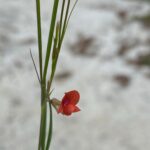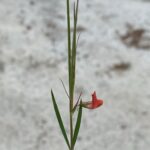Λάθυρος ο τριχόφυλλος
Etymology of Lathyrus setifolius: Lathyrus comes from the Ancient Greek word "Lathyros" [Λάθυρος], from the prefix "λα-" [la-] meaning "extremely," and the suffix "-θυρος" [–thyros] meaning "passionate", referring to the ancient belief in the plant's supposed aphrodisiacal powers. "Setifolius" comes from the Latin "seta", meaning "hair" and "folius", meaning "leaf", hence "with hairy leaves". There are distinct characteristics of the plant such as the small size of the flower or its slender, grass-like leaves, but certainly the "hairy leaves" is an unfortunate name given to this species.
There are at least 14 Lathyrus species/taxa growing on their own in the wild Cypriot habitat. There are some additional domesticated species and subspecies growing in gardens.
Lathyrus setifolius is an endangered plant in Cyprus. Despite this, I have encountered it twice, in Pano Platres (Lemesos district) at an altitude of around 1250 metres, and at the Kykkos Monastery (Nicosia district), at an altitude of 1325 metres. Surprisingly, so far it has been recorded at altitudes not higher than 100 metres, in western, northeastern and southeastern Cyprus. Evidence shown below in the pictures will prove that this is indeed Lathyrus setifolius growing at high altitudes as well. Its flowering period is between February and April.
How to identify Lathyrus setifolius:
L. setifolius resembles blepharicarpos, cicera, and sphaericus.
Blepharicarpos's flower is more orange rather than red. Its stipules are the widest of the four, in setifolius the stipules are grass-like (an extremely important identification factor), and in fact, are the narrowest. The corolla's size is larger than 1cm, for setifolius the corolla is not usually not exceeding 1cm (an extremely important identification factor).
Cicera's flower is also red but it is twice the size of setifolius. Cicera's stipules are much wider than the ones of setifolius and definitely not grass-like.
For sphaericus the flower's valves appear with numerous prominent longitudinal veins; this doesn't happen with the other three mentioned already. Its corolla is larger than 1cm.






